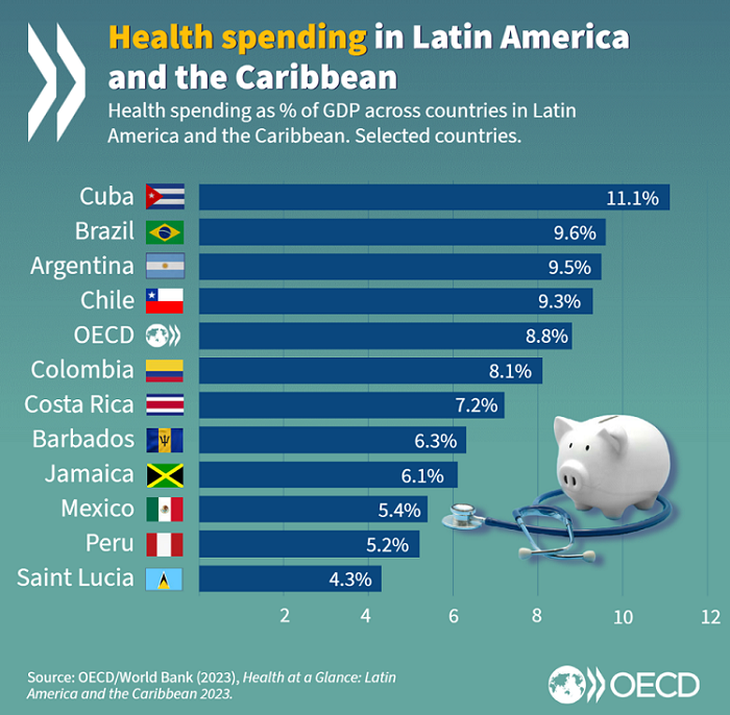A recent OECD document provides an assessment of the performance of national health systems in 33 countries. Argentina shares the leadership with Brazil and Cuba.
According to OECD, Argentina is one of the three countries with greater investment in health. This was reflected in the report “Health at a Glance: Latin America and the Caribbean 2023). In this way, the country ranked third with 9.5% of health spending as a percentage of GDP, a leadership that competes against Cuba (11.1%) with the highest investment and Brazil (9.6%).
The content you want to access is exclusive to subscribers.
“Health at a Glance: Latin America and the Caribbean 2023” provides an assessment of the performance of national health systems in 33 countries of Latin America and the Caribbean (LAC) with a complete set of indicators on health and medical care.


The report highlights that, despite the spending in response to the pandemic in recent years, addressing structural challenges to health in LAC is a unfinished and urgent agenda. Health systems in the region must be better prepared to deal with emerging threats or risk new tragic outcomes. Other key takeaways include:
- Lhealth systems suffer from scarcity of resources. On average, compared to the OECD, the LAC region has almost half as many doctors per 1,000 inhabitants (2.0 in LAC and 3.5 in the OECD), almost a third as many nurses (3.5 in LAC already 10.3 in the OECD) and less than half of hospital beds (2.1 in LAC and 4.3 in the OECD)
- Despite COVID-19, life expectancy continues to increase, but its distribution is uneven. Life expectancy in LAC has increased by 4 years since 2000 and reached 75.1 years in 2021, but remains below the OECD average of 80.4 years. Women are expected to live 5.5 years longer than men. The highest life expectancies are found in Chile (81.0 for men and 83.8 for women) and Costa Rica (80.8 for men and 83.3 for women). The lowest life expectancies are found in Haiti (64.3 for men and 66.5 for women) and Guyana (70.0 for men and 73.2 for women).
- Noncommunicable diseases were the most common cause of death, accounting for 77% of all deaths. Cardiovascular diseases are the main cause, with 218 deaths per 100,000 inhabitants in 2020, 61% more than the OECD average. Cancer mortality has decreased in LAC by 2.3% since 2000, but not as rapidly as the 15.4% decrease observed in the OECD on average
- In LAC, private spending on health is higher than in the OECD. On average, 32.4% of healthcare spending in LAC was paid out-of-pocket in 2019, above the OECD average of 20%.
OECDHealth.png

Other conclusions
Most of the excess deaths in LAC occurred among men (60% of the total) and people aged 60 and over (75%). Argentina, Venezuela, Chile, Cuba, Costa Rica, Panama, Uruguay, Jamaica, and Trinidad and Tobago had lower excess mortality, averaging 34% fewer excess deaths than the OECD average. Peru, Bolivia, Mexico, Ecuador, Saint Vincent and the Grenadines, and Guyana had high mortality, totaling 48% of excess deaths in LAC and representing 29% of its population.
- Health linked to climate change
The severity of climate-related health threats is growing faster than the ability of LAC health systems to mitigate and adapt to a changing climate.
Annual deaths of adults aged 65 and over attributable to heat exposure in LAC increased on average by almost 240% between 2000-04 and 2017-21. Between 2012 and 2021, the basic reproduction number (R0) for dengue increased by between 0.32 and 0.46, depending on the mosquito species, compared to the 1951-60 baseline.
- He overweight, obesity and rapid aging of the population are driving a rapid epidemiological transition towards noncommunicable diseases.
Being overweight is one of the most pressing health risk factors in LAC. The average body mass index increased between 2000 and 2017, reaching 26.9 for both men and 28.3 for women, above the threshold of 25 for overweight and approaching the obesity threshold of 30.
-
It is expected that the proportion of the population over 65 years more than double by 2050, reaching more than 18% of the LAC population. This is significantly lower than the 27.7% expected across OECD countries on average, but aging in the LAC region will drastically affect healthcare. The proportion of the elderly population will be particularly large in Barbados, Chile and Cuba, exceeding 25% by 2050.
Source: Ambito




